Tu-16: aircraft era. Part I. On the way to the legend. Predecessors
In the second half of the forties, before the aircraft industry of the world's leading aviation powers were faced with the difficult task of creating long-range jet and turboprop bombers capable of cruising at speeds close to the speed of sound, while maintaining the payload and range at a level no less than that of aircraft of the B-29 type and its domestic counterpart - Tu-4 ...
The need for such machines was dictated not only by the general achievements of technical progress in aviation science and technology, the main ways of their further development, but also by the significantly increased power of fighter aviation (the mass appearance of jet fighters, including interceptors, with speeds of the order of 1000 km / h), air defense equipment, radar systems with long-range detection. The appearance of a new type of weapon - a nuclear bomb that made a breakthrough towards targets for a relatively small number of bombers catastrophic for the enemy - had a special impact.
For the USSR, the presence of a long-range bomber - carrier of the atomic weapons with a TRD capable of reaching targets at a distance of up to 3000 km, it was indeed a vital program. This machine was supposed to be an effective deterrent capable of delivering a nuclear attack on the European and Asian military bases of the United States, on important political, economic and military centers of NATO countries, as well as waging an effective struggle with enemy warships, including oceanic the transportation of the United States to the European continent, without which the continued fighting of the American allies against our country would have been impossible.
According to the views of the Soviet command, the new bomber was supposed to change in the early fifties in our Long-Range Aviation the already obsolete Tu-4. It was clear that by the end of the 1940s, the possibilities for modern and increasingly advanced air defense systems to break through had to be significantly reduced compared with the 1944-1945 years. And it should be noted that these assumptions soon received a clear confirmation: the collisions of the American B-29 heavy-duty screw bombers with our MiG-15 jet fighters in the Korean sky in 1951-1953 put an end to the career of piston long-range and intercontinental bomber. The future was for machines equipped with promising turbo-jets and turboprop engines.
However, to create such an aircraft, it was necessary to solve a number of complex problems associated with the aerosodynamics of transonic velocities which were little studied at that time. One of these tasks was the introduction of the swept wing in the practice of heavy aircraft.
One of the first to build bomber with an arrow-shaped wing and tail feathers began OKB AN. Tupolev. The first practical step towards creating such machines in this design bureau was the “82 aircraft” project. The machine was developed for two turbojet engines RD-45F, which had a maximum thrust of 2270 kgf or VK-1 with take-off thrust of 2700 kgf. The “82 airplane” was designed to achieve near-sonic flight speeds of the order of Mach 0,9-0,95. The project was based on the development of the 73 aircraft, a prototype of the Tu-14, orthoptera jet bomber (described in the article The Difficult Fate of the Tu-14), differing in the use of the swept wing, reduced to three people, by crew and power plant in composed of two turbojet engines (on the prototype three engines of two types were installed, which was clearly a forced and not rational solution). Getting rid of the third engine made it possible to more rationally build the plane, equipping a rifle installation in the free stern. The tail installation with two rapid-fire cannons and extended sectors of shelling provided sufficient protection for the bomber from threatened angles and made it possible to abandon the upper and lower rifle defensive installations used on the prototype, bringing a significant gain in weight. The new machine became more compact, and its take-off weight was reduced to 13,5 t. A preliminary draft design of the “82 aircraft” was prepared in the spring of 1948.
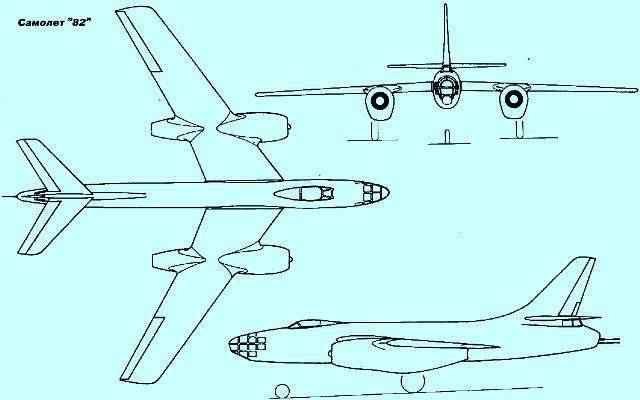
The creation of a new car was approved by the relevant decision of the USSR Council of Ministers in June 1948 of the year, which gave the aircraft the name Tu-22. The wing of the machine was a two-spar construction with a working panel covering of large thickness with a stringer set, forming a powerful carrier unit - the caisson, which perceives the entire set of flight loads. The wing was equipped with mechanization in the form of flaps, used on landing. The tail assembly had a design similar to that of the wing, differing in the increased sweep of the 40 °. In the fuselage was located the front pressurized cabin, which housed the pilot and navigator, and the rear pressurized cabin, where the gunner’s workplace was equipped. The control wiring was hard, with reversible power boosters. There were brake pads on the fuselage.
Initially, the aircraft was equipped with two engines RD-45F, then they were replaced by more powerful VK-1. Re-equipment did not require reworking of the engine nacelle: the engines were interchangeable in dimension and seat, so that it was enough just to change the front cowling of the hoods. The fuel was placed in the 16 soft tanks, which were located in the wing box, as well as in the fuselage, near the center of mass. Fuel capacity was 7495 l. In addition to armament, the aircraft was equipped with an AFA-BA / 40 camera for carrying out planned surveys mounted at an angle 10 ° to the vertical back and intended for conducting side-by-side reconnaissance and photo monitoring of the results of the use of weapons.
Although the aircraft was built as an experimental one, it was equipped with all the standard equipment for machines of its class. The connection with the ground was provided by the RSB-ZbisAD radio station; the 12РСУ-10 station served for inter-flight communication. The set of equipment included the respondent of the state recognition system “Barium” and standard flight navigation equipment. As you can see, the plane was a full-fledged bomber, having similar equipment similar to the Tu-14 and capable of carrying up to 3 t bombs of various caliber, including three-ton. In the stern installation there were two G-23 or HP-23 cannons with ammunition in 200 ammunition for each barrel. For firing on the course served as a fixed gun HP-23 from the starboard side with 100 cartridges. The pilot fired from it with the help of the automatic sight АSP-3, the aft installation was equipped with the sight АSP-5П. The cockpit was protected by armor, covering the pilots from the back of fighter aircraft and shrapnel of anti-aircraft shells from below. The seats of all crew members were covered with 12-mm steel armored spats and 8-mm duralumin armor bottom, the windshield of the pilot's lantern was made of 65-mm transparent armor. All three jobs were equipped with ejection seats.
Works went the most energetic way. Production of the first copy began in July 1948 year. Construction of the machine with TRD RD-45F was completed a year later after the start of the design, in the middle of February, 1949. 24 March 1949 new aircraft made its first takeoff. During the factory tests, the main specified characteristics were confirmed. The maximum speed was 931 km / h, the maximum flight height 11000 m and range - 2395 km. The Tupolev machine gained 5000 height in 5,8 minutes, three times faster than the Tu-4. The Il-28 serial bomber with similar engines and equal combat load "82 Aircraft" outpaced the maximum speed on 100 km / h, on the climb rate - on 22%, although somewhat inferior in take-off and landing qualities, having a large run-up length. The flight range of the eighty-second and IL-28 was almost the same.
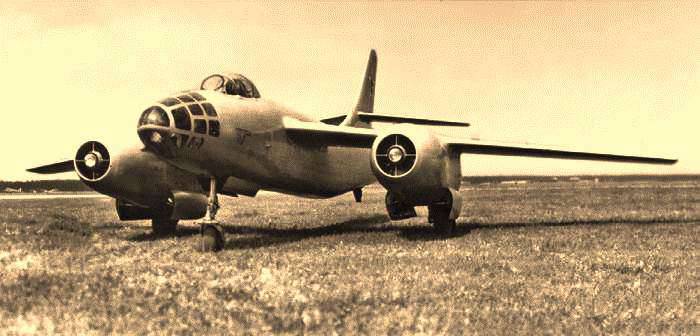
For all its novelty (it is worth remembering that the swept wing for heavy vehicles in our country was created for the first time) during the testing of the bomber did not need to make any serious modifications to the design. In addition, the design of the machine has been tested for serial construction. “Eighty-second” confirmed his qualities in case of an emergency incident that happened to him during one of his flights. The plane at low altitude hit the chatter and was damaged by one of the engines, which almost fell off the engine mount. However, the pilot was able to return to the airfield on the remaining engine and sit down normally.
The fate of the 82 aircraft was short: at the end of the test program, the car was mothballed, and the development of its “combat version”, which was being prepared for serial production, was curtailed. This bomber, created under the designation "83 aircraft", was an enlarged model with an elongated fuselage fitted with an upper two-gun rifle unit and a PSBN radar bomber sight, for which the radio operator was introduced into the crew. Another option for aircraft equipment to ensure all-weather bombing in the absence of land visibility was the installation of the Rym-S radio navigation system used to launch a combat aircraft on target.
All work on this bomber was discontinued at the end of 1949, because the Air Force was completely satisfied with the recent large-scale Il-28 series, and did not express much interest in the new aircraft with slightly different characteristics. Nevertheless, the development of the 82 aircraft gave invaluable experience in creating a swept-wing bomber, largely predetermining the future success of the Tu-16. It is worth remembering that it was the first Soviet heavy machine with a jet engine and swept wings, which allowed in real conditions to study the behavior of the wing with a sweep at speeds of more than 900 km / h. "Eighty second" well passed factory tests. This car belonged to the class of a front-line jet bomber and in many respects was a continuation of the previous work of the Tupolev Design Bureau on machines of the same class “73” and “78”.
The next project, being developed under the code "486 aircraft", was already a bomber of "medium weight category", calculated at a distance of up to 4000 km. It was also created on the basis of the “73 aircraft”, which they planned to equip with an arrow-shaped wing and two more TRDs with much more thrust. Calculations showed that in order to obtain decent flight performance, it was necessary to provide traction characteristics twice as high as the previous ones. The calculation was made on the AM-TKRD-300 engines (AM-02) created by the engine-building OKB-02, which would provide the total static thrust 9560 kgf - almost twice as much as the one that the “73” had, which had three 5600 kgf engines. It is pertinent to note that the decision itself on the introduction of an arrow-shaped wing was the result of the high thrust-to-weight ratio of the aircraft, the rational use of which the straight wing no longer provided, as the car went into the zone of critical Mach numbers.
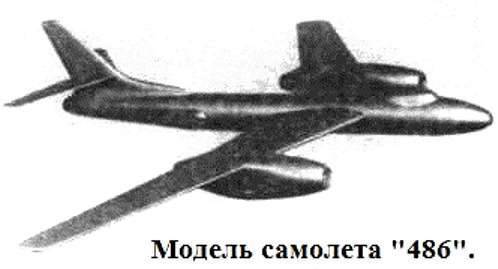
Preliminary study of the project showed that the aircraft will inevitably add weight. The reasons for this were higher fuel consumption of powerful engines, which, given the achievement of the required range, was to reach 10-12 t, as well as the need to meet the increased requirements for structural strength, respectively, at high speeds. The maximum speed was set equal to 1020 km / h, the range with a ton of bombs was to be 3500-4000 km, the estimated takeoff distance of the heavier machine was 1700 m. The weight of the empty plane was determined to be 18,5 t, the take-off weight was 31,5 t.
The project looked like a kind of compilation, retaining the old fuselage of the “73 aircraft” with the new wing and tail unit. The wing of the “486 plane” generally repeated the wing of the “82 plane” while maintaining the sweep of the 35 °, but to achieve the desired characteristics, the elongation increased to 8,15. The new aircraft grew in size, which caused a corresponding increase in the tail area, the landing gear intensified, which got twin wheels on the nose strut. The defensive armament consisted of one fixed gun HP-23 for firing forward with 180 ammunition ammunition, aft installation with a pair of G-20 guns, upper and lower units equipped with twin guns of the same models with general 1200 ammunition ammunition. The composition of the bomb load could include bombs of different calibers up to three tons.
Work on the "486 aircraft" was completed at the preliminary design stage. The designers realized the futility of the “hodgepodge” - a scheme combining a new progressive wing with the aggregates of the previous models. Instead, at the beginning of 1949, they began to design a full-fledged long-range bomber under the code "86 aircraft". The appearance of the future machine has undergone a number of significant transformations. Initially, the possibility of modification of the orthoptera Tu-14 equipped with AM-02 engines was considered. However, purging conducted at TsAGI led to a “change of course” in favor of a more promising swept-wing scheme. The car went further and further away from the prototype. Initially, it was planned to meet the empty aircraft weight equal to 21,7 t, and the reloading weight 36,0 t. The fuel reserve increased to 17,2 t, the maximum bomb load increased to 6000 kg, and the normal load doubled to 2000 kg. The maximum speed was set equal to 980 km / h, the ceiling 13400 m, the range with 2 tons of bombs - 4000 km.
The aircraft was larger than the previous sample, having a larger diameter and length of the fuselage with an increased bomb bay. Its remarkable feature was the recessed lantern cockpit instead of the former protruding drop-shaped cap. The reason was the desire to reduce drag, taking into account layout considerations: according to the requirements of longer range, the crew increased at the expense of the second pilot. The speaker was only a blister-radio operator, from where he controlled the shooting from the top of the installation with a pair of HP-23. Another pair of guns of the same caliber was located in the aft installation. A built-in gun in the nose of the aircraft was intended for fire ahead.

Meanwhile, research continued to determine the optimal parameters of the swept wing for an aircraft of the type being created - a twin-engine jet bomber with a take-off weight on the order of 40 t. The aerodynamics of OKB-156 presented a report on the topic "Studies of the area and wing extension on the flight characteristics of an aircraft with a swept wing." According to calculations, an increase in the range of the original sample can be achieved by extending the wing to 10, and increasing the area to 100 square. m. Accordingly, it was decided to revise the original design of the "86 aircraft", with a change in the size and area of the wing, increasing the length of the fuselage and fuel capacity. According to the new project, the flight range with a bomb load in 2 tons increased to 4750 km, other characteristics remained unchanged. Also, the shape of the nose was changed, which became a somewhat pointy shape and the number of fuel tanks in the fuselage was increased. If in previous projects it was difficult to see the features of the future Tu-16, then the layout of the new version, and all the general outlines of the fuselage in general, have already become similar to the usual look of this long-range bomber. Detailed study of the device cabs, weapons and equipment was useful in the future, being virtually unchanged implemented in the design of the Tu-16.
However, the overall result was not joyful: with these requirements, it was impossible to provide the specified dimension. The design practice dictated its own laws: the existing turbofan engines were distinguished by high fuel consumption, and the achievement of the desired speeds was accompanied by an even greater increase in fuel consumption. Provided for the draft TRD AM-02 on cruise flight mode for an hour consumed almost eight tons of fuel, to ensure a given range of its stock was to be several tens of tons. To meet the conditions, the dimensions and weight of the machine needed to be increased, but the heavier bomber needed to be equipped with 1,5-2 engines with a larger thrust. As a result, work on this version of the "eighty-six" was discontinued at the preliminary design stage.
Another problem was the lack of efficient engines required thrust. At that time, the most realistic in the required dimensions were TRD development by OKB-300 A. A. Mikulin and OKB-165 A. M. Cradles, but they still did not reach the required level of performance and reliability. The AM-300 aircraft engine created by OKB-02 turned out to be a typical “first pancake” with a lot of problems. A.M. Mikulin initially set the bar high, taking on the creation of a super-powerful, for those times TRD (recall that the most powerful Soviet jet engines VK-1, which at that time were in production, developed the maximum thrust of 2700 kgf). Being one of our most experienced and talented aircraft engine designers, Mikulin also had excellent organizational skills with a real sense for capable people. His closest assistant was B. S. Stechkin, a well-known motor theorist and world famous calculator, who possesses extensive knowledge in thermodynamics, gas dynamics, and strength problems. The tandem of a competent designer and a talented theoretical scientist turned out to be very productive.
The AM-TRD-02 engine was a TRD with an axial nine-stage compressor providing a compression ratio of five and an air flow rate of 75 kg / sec with a tubular-annular combustion chamber, which was equipped with a counter-flow and a single-stage turbine to reduce weight and size. The maximum AM-TRD-02 thrust was 4250 kgf, the nominal 3850 kgf, the specific fuel consumption in the nominal mode was no more than 1,02 kg / kg.hour.
As an alternative, the TR-165 engine developed in OKB-3 with the maximum thrust in 4500 kgf was considered. A.M. Cradle was a pioneer in the development of domestic gas turbine engines, providing his first draft TRD even before the war. In the post-war period, the work of its design team continued in a special department of the turbojet engines of the Research Institute of Aviation Commissariat of Aviation Industry, and from 1948, it was transformed into the newly formed OKB-165. The TR-3 engine created by him (AL-3) was distinguished by an advanced design, but the percentage of novelty had a downside: the performance of the “raw” design was extremely weak, and the resource initially amounted to only 50 hours. Part of the problems were solved on a modified version of the TR-ZA (AL-5), calculated on a five-ton craving. It was a TRD axial seven-stage compressor, an annular combustion chamber with 24 vortex burners, a single-stage turbine and a rigid conical nozzle. A sufficient degree of engine performance allowed us to count on its serial production.
Under these promising turbojet engines, the design of a new version of the bomber called the “87 aircraft” was launched. With the exception of the modified power plant, the new project was practically no different from the previous sample. The draft design of the machine was completed in July of the 1949 of the year, but no further work followed.
Another project was the 491 aircraft developed by B. M. Kondorsky’s project team. This machine was a version of the "86 aircraft", designed for high flight speed, for which the AM-02 or TP-3 thrust was enough with a margin. Unlike previous projects, the wing sweep was increased to 491 ° on the “45 plane”, otherwise the aircraft did not undergo any significant changes. The aircraft was calculated to reach a maximum speed of up to 1085 km / h, the range with a bomb load in 2000 kg of bombs was 5000 km. But this project was also closed at the stage of technical proposal due to the poor knowledge of the sweep wing over 37 °. Tupolev, true to his principle, showed “healthy conservatism” and did not take risks because of the expected increase of several tens of kilometers per hour. This direction was postponed for the future when the question arises about the achievement of supersonic flight speeds by the bombers. So far, preference has been given to “tit in hands” - a sufficiently aerodynamically and constructively developed wing with an 35 ° sweep.
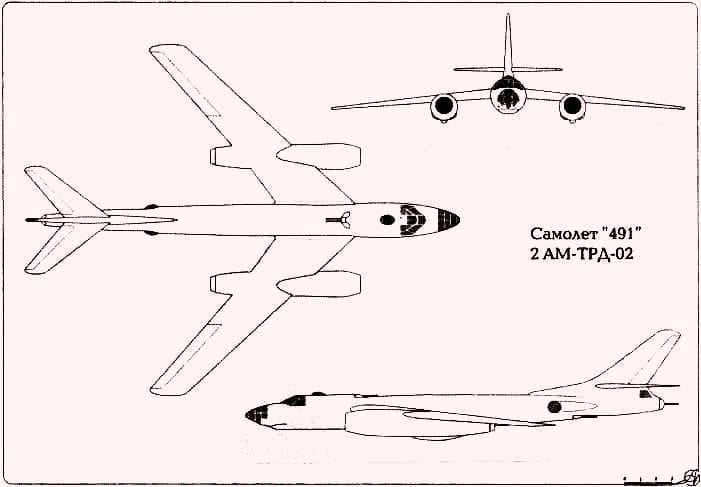
In the autumn of 1949, the Air Force issued an official order to create a new long-range jet bomber for two turbojet engines designed by the design bureau A.Lülki, AL-5 with takeoff thrust equal to 5000 kgf. The corresponding Resolution of the Council of Ministers on a new bomber was issued, according to which the development of a new car was entrusted to the OKB-240 S.V. Ilyushin. The main reason for this decision was the success of the IL-28 front-line bomber and its actual victory in an unofficial competition with Tupolev Tu-14. Considering the short period that was released for the design and manufacture of the prototype aircraft, named IL-46, and the absence in OKB-240 of the experience of flight refinement and testing of heavy aircraft with swept wings (developed in OKB-240, an experienced bomber with a similar wing -30 performed only a few runways runs). SV Ilyushin made a reasonable decision to create two prototypes. One of them, IL-46 with a straight wing, generally followed the IL-28 scheme, and the second, IL-46, equipped with a swept wing.
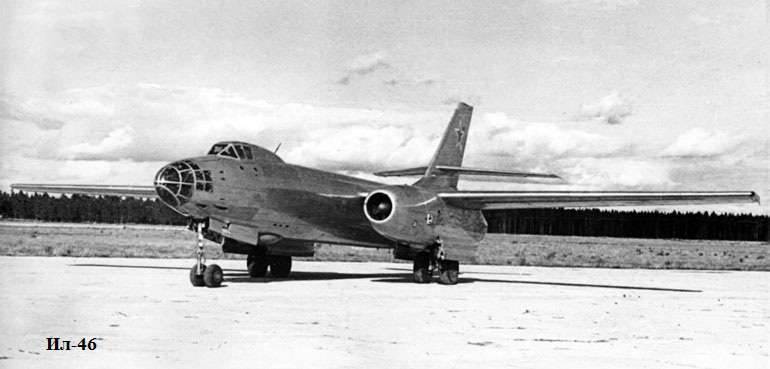
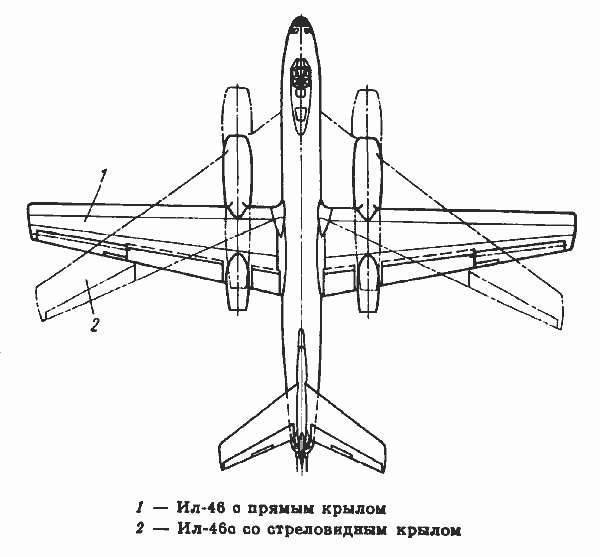
Experienced orthoptera Il-46 was ready for flight tests for the spring 1952 of the year. He passed the stage of factory testing without any problems, and went to the State, during which he confirmed the compliance of the flight performance with the specified. Everything was all right for the Ilyushin machine, the plane could be transferred for serial development, or it was possible to proceed to the construction of an IL-46 with a perspective swept wing. But it turned out that a long-range bomber with a similar wing was already flying, and it was created by the initiative A. N. Tupolev. At the same time, the Tupolev machine, which has the internal name “88”, has already shown, in factory tests, a maximum speed of more than 1000 km / h, which significantly exceeded the one set by the task. The government of the country decides to transfer to the serial production of the "eighty-eighth", and to stop work on IL-46, including its arrow-shaped variant. OKB A. N. Tupolev succeeded in taking revenge for the Tu-14, creating the Tu-16 for the country, overtaking his time for several years by the characteristics and technical solutions and becoming one of the recognized masterpieces of domestic and global aircraft manufacturing.
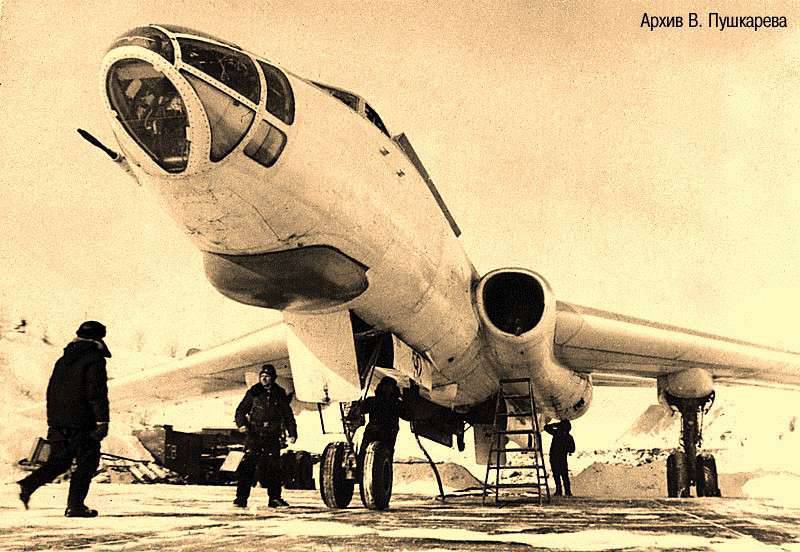
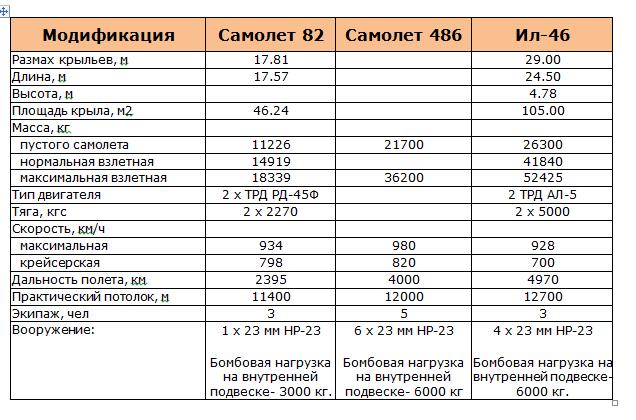
Sources:
Rigmant V, How was created Tu-16. About the predecessors of the great aircraft // Wings of the Motherland. 2002. No.5. C. 18-25.
Markovskiy V., Prikhodchenko I. The missile carrier Tu-16. The triumph of the Soviet aviation industry. M .: Yauza, 2015. C.174-191.
Rigmant V. Tu-16. Birth of a long-liver // Aviation and cosmonautics. 2002. No.5. C. 20-28.
Gordon E, Kudryavtsev V., Rigmant V. Legendary Tu-16 // Aviation and Time. 2001. No.1. C.4-24.
Gordon E, Kudryavtsev V., Rigmant V. Legendary Tu-16 // Aviation and Time. 2001. No.2. C.4-22.
Yakubovich N, Artemyev A. Tupolev Tu-16. Long-range bomber and missile carrier. M .: AST, 2001. C.12-34, 48-97, 111-122.
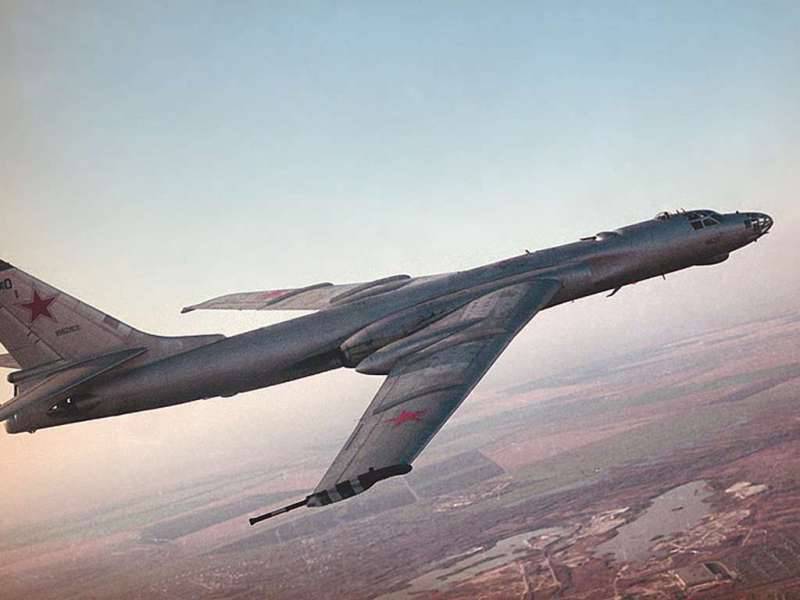


Information